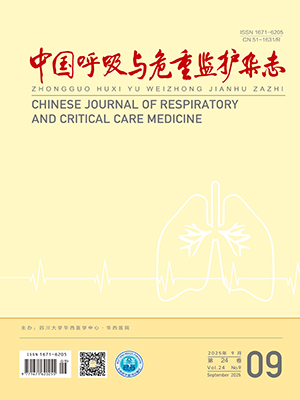| 1. |
Zein H, Baratloo A, Negida A, et al. Ventilator weaning and spontaneous breathing trials; an educational review. Emerg (Tehran), 2016, 4(2): 65-71.
|
| 2. |
Hartmann SM, Zimmerman JJ. Standardization of ventilator weaning benefits both researchers and clinicians. Crit Care Med, 2017, 45(1): 139-140.
|
| 3. |
Pinheiro BDV. The difficult task of searching for tools that help predict mechanical ventilator weaning success. J Bras Pneumol, 2017, 43(4): 249-250.
|
| 4. |
Tobin MJ, Laghi F, Jubran A. Ventilatory failure, ventilator support, and ventilator weaning. Compr Physiol, 2012, 2(4): 2871-2921.
|
| 5. |
Branson RD. Modes to facilitate ventilator weaning. Respir Care, 2012, 57(10): 1635-1648.
|
| 6. |
Vieillard-Baron A, Prin S, Chergui K, et al. Echo-Doppler demonstration of acute cor pulmonale at the bedside in the medical intensive care unit. Am J Respir Crit Care Med, 2002, 166(10): 1310-1319.
|
| 7. |
Noritomi DT, Vieira ML, Mohovic T, et al. Echocardiography for hemodynamic evaluation in the intensive care unit. Shock, 2010, 34(Suppl l): 59-62.
|
| 8. |
Rudski LG, Lai WW, Afilalo J, et al. Guidelines for the echocardiographic assessment of the right heart in adults: a report from the American Society of Echocardiography endorsed by the European Association of Echocardiography, a registered branch of the European Society of Cardiology, and the Canadian Society of Echocardiography. J Am Soc Echocardiogr, 2010, 23(7): 685-713.
|
| 9. |
张青, 刘大为, 陈焕, 等. 超声观测不同部位下腔静脉内径形变指数的研究初探. 中华内科杂志, 2015, 54(6): 491-495.
|
| 10. |
Price S, Nicol E, Gibson DG, et al. Echocardiography in the critically ill: current and potential roles. Intensive Care Med, 2006, 32(1): 48-59.
|
| 11. |
Gerstle J, Shahul S, Mahmood F. Echocardiographically derived parameters of fluid responsiveness. Int Anesthesiol Clin, 2010, 48(1): 37-44.
|
| 12. |
Vieillard-Baron A, Caille V, Charron C, et al. Actual incidence of global left ventricular hypokinesia in adult septic shock. Crit Care Med, 2008, 36(6): 1701-1706.
|
| 13. |
Oropello J, Rahmanian M. Can chest sonography predict and facilitate successful ventilator weaning?. Crit Care Med, 2013, 41(8): 2065-2067.
|
| 14. |
Caille V, Amiel JB, Charron C, et al. Echocardiography: a help in the weaning process. Crit Care, 2010, 14(3): R120.
|
| 15. |
Salem R, Vallee F, Rusca M, et al. Hemodynamic monitoring by echocardiography in the ICU: the role of the new echo techniques. Curr Opin Crit Care, 2008, 14(5): 561-568.
|
| 16. |
王小亭, 刘大为, 于凯江, 等. 中国重症超声专家共识. 中华内科杂志, 2016, 55(11): 900-912.
|
| 17. |
Morris C, Bennett S, Bum S, et al. Echocardiography in the intensive care unit: current position, future directions. J Intensive Care Soc, 2010, 11(2): 90-97.
|




